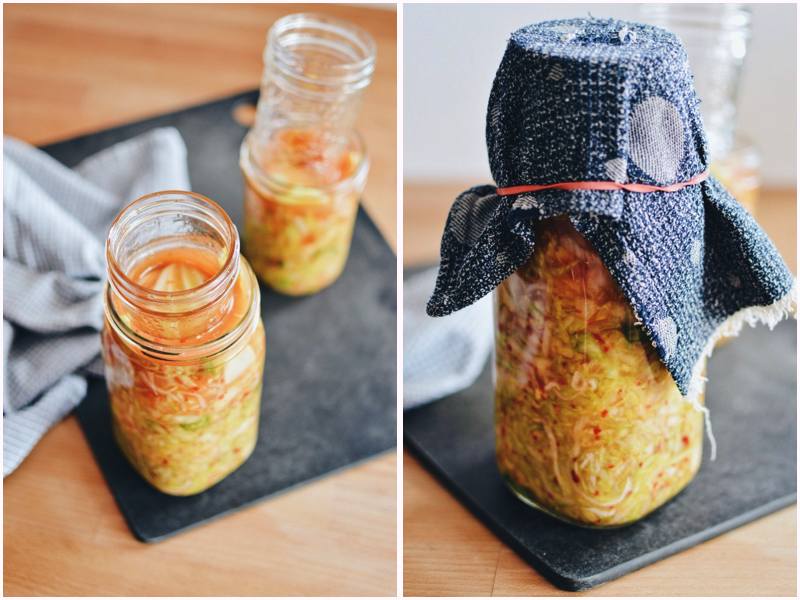There’s something magical about fermentation. In this case, it’s a process by which over salted vegetables yields a highly delicious product. Simple to make and packed full of tangy flavour, kimchi kraut is a tasty addition to nearly anything.
I think Michael Pollan described it accurately in the Air episode of his Netflix series Cooked,
“All cooking is transformation, and in that sense it’s miraculous, it’s alchemy. But of all the different transformations we call cooking, I think fermentation is the most miraculous and the most mysterious, and that’s because it doesn’t involve any applied heat at all. This is food and drink made strictly through the action of bacteria and fungi.”
Have you seen that series? If not you should stop reading and go watch it… so good!
Originating in Korea, kimchi is a broad term used to describe many varieties of fermented vegetables. This recipe is a riff on traditional sauerkraut techniques, with the addition of kimchi flavours (If you wanted to make sauerkraut, follow the same steps using just cabbage and salt). Using green cabbage in place of the more commonly used napa cabbage results in a particularly pleasing crunch that is maintained throughout the fermentation process.
If you’ve never fermented before, this is a good place to start, the instructions may seem lengthy at first glance, but the process is simple and relatively straight forward. You start by chopping and salting cabbage, then you mix it with chili paste, cram it into jars, weigh it down, cover and allow the naturally occurring microorganisms to do their thing.
This recipe can be easily scaled up. I have often made kimchi kraut in large batches, using a cooler or my biggest stock pot to mix everything in and fermenting in 1.9L wide mouth mason jars.
Kimchi Kraut
yields: about 1.5 quarts (1.5L)
* as always I encourage you to use organic ingredients
* all percentages are calculated based on the total amount of cabbage in grams
Ingredients
- 2 small or 1 large (about 2.5lbs or 1135g) Green Cabbage
- 2 Tbsp. (12g or 1.1%) Red Chili Flakes
- 2 large cloves (17g or 1.5%) Garlic
- 2″ piece (25g or 2.2%) Ginger
- 1 (140g or 12.4%) Yellow Onion
- 4-5 tsp. (28-35g or 2-3%) fine sea salt (don’t use iodized table salt, iodine is antimicrobial and could inhibit fermentation)
- 1 bunch green onions
- 1 daikon radish
- 1 quart (1L) + 1/2 quart (0.5L) wide mouth mason jar (washed with hot soapy water, but no need to sterilize)
- two small jars or glasses that fit inside your wide mouth mason jars (alternatively you can use zip lock bags filled with brine – 2 cups water 2Tbsp. sea salt) to be used as weights to keep cabbage submerged
Start by making the chili paste: using an immersion blender (a food processor works well for larger amounts, but for the amounts used in this recipe I had best results using an immersion blender) combine chili flakes, garlic, ginger and onion until well blended to form a paste.
Set aside a few of the outer layers of cabbage leaves. Thinly slice cabbage and place in a large bowl, salting as you go. Thinly slice daikon radish, chop green onion into 1″ pieces and add to the cabbage. Mix thoroughly and taste, it should be aggressively salted, but as Sandor Katz says “not unpleasantly so”.
Mix chili paste into vegetables, taste again and add more salt if necessary.
Pack mixture into jars, a few handfuls at a time, pressing firmly with your fist to remove air and help release water from vegetables which makes up the brine (sometimes I use my rolling pin to tamp it down). Continue filling jars leaving an inch or two of room, top with a piece of cabbage leaf that you set aside, then weigh down using a jar that fits inside, cover with a cloth and secure with an elastic band. Place jars out of direct sunlight, and allow the fermentation to begin! (I also place a baking tray under the jars to catch any liquid that might spill over).
After a day or two you will start to see bubbles forming, a good sign that things are active and alive. Every few days check on your kimchi, remove the weight jar and rinse under hot water, skimming off any foam/scum from the surface. You want the cabbage to remain submerged, so add brine if necessary (2cups water + 2Tbsp. sea salt). Replace weight jar, cover and let the fermentation continue.
Taste kimchi each time you check on it. After a week or so it should start to taste slightly sour and pleasantly funky. When it develops a flavour you like, put a lid on the jar and transfer to the fridge. (open jar regularly to release any gasses that have built up).






